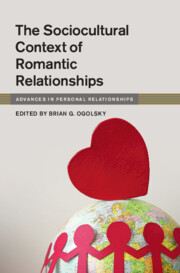Book contents
- The Sociocultural Context of Romantic Relationships
- Advances in Personal Relationships
- The Sociocultural Context of Romantic Relationships
- Copyright page
- Contents
- Contributors
- 1 The Sociocultural Context of Romantic Relationships
- 2 Systemic Racism and Romantic Relationships
- 3 Sociocultural Perspectives on Romantic Relationships
- 4 Gender and Heteronormativity in Romantic Relationships
- 5 Social Class, Neighborhoods, and Romantic Relationships
- 6 Religion and Spirituality in Romantic Relationships
- 7 The Importance of Work in Romantic Relationships
- 8 History and Cohort Effects in Romantic Relationships
- 9 The Legal Meaning of Sex (and Romantic Relationships)
- 10 Romantic Relationships and Traditional Media
- 11 Romantic Relationships and Social Media
- 12 Situating Latinx Immigrant Romantic Relationships in the Context of Illegality
- 13 Romantic Relationships during a Global Pandemic
- Index
- References
12 - Situating Latinx Immigrant Romantic Relationships in the Context of Illegality
Using a Socioculturally Attuned Lens
Published online by Cambridge University Press: 19 October 2023
- The Sociocultural Context of Romantic Relationships
- Advances in Personal Relationships
- The Sociocultural Context of Romantic Relationships
- Copyright page
- Contents
- Contributors
- 1 The Sociocultural Context of Romantic Relationships
- 2 Systemic Racism and Romantic Relationships
- 3 Sociocultural Perspectives on Romantic Relationships
- 4 Gender and Heteronormativity in Romantic Relationships
- 5 Social Class, Neighborhoods, and Romantic Relationships
- 6 Religion and Spirituality in Romantic Relationships
- 7 The Importance of Work in Romantic Relationships
- 8 History and Cohort Effects in Romantic Relationships
- 9 The Legal Meaning of Sex (and Romantic Relationships)
- 10 Romantic Relationships and Traditional Media
- 11 Romantic Relationships and Social Media
- 12 Situating Latinx Immigrant Romantic Relationships in the Context of Illegality
- 13 Romantic Relationships during a Global Pandemic
- Index
- References
Summary
In this chapter, we examine the nascent research on Latinx immigrant romantic relationships, with a particular focus on Central American undocumented and mixed-status immigrant partners rearing children in the United States. We use a socioculturally-attuned lens to reflect on the ways in which the context of illegality shapes romantic relationships between partners, where at least one person is undocumented. As we discuss, illegality is a term used to refer to the US immigration laws, policies, and practices that expose immigrants and their families to discrimination, exploitation, victimization, criminalization, detainment, deportation, and family separation based on liminal legal statuses. We argue in this chapter that illegality is a powerful structural force that transcends cultural explanations of Latinx immigrant romantic relationships. We draw upon a recent study of Central American immigrant women in romantic relationships to apply our socioculturally-attuned lens and underscore how illegality conditions and constrains their relational experiences and opportunities while residing in the United States. We conclude with considerations for family and relationship scholars of immigrant family life seeking to advance immigrant justice.
Keywords
- Type
- Chapter
- Information
- The Sociocultural Context of Romantic Relationships , pp. 226 - 246Publisher: Cambridge University PressPrint publication year: 2023



